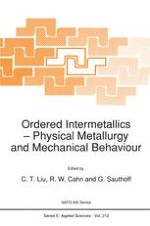1992 | OriginalPaper | Chapter
Deformation and Fracture of Intermetallic Compounds Having the L12 Crystal Structure
Author : David P. Pope
Published in: Ordered Intermetallics — Physical Metallurgy and Mechanical Behaviour
Publisher: Springer Netherlands
Included in: Professional Book Archive
Activate our intelligent search to find suitable subject content or patents.
Select sections of text to find matching patents with Artificial Intelligence. powered by
Select sections of text to find additional relevant content using AI-assisted search. powered by
Intermetallic compounds having the L12 structure show many unusual mechanical properties. For example, many show an anomalous temperature dependence of the flow stress which has been related in various models to the structure of screw dislocation cores. Others, however, show a bcc-like behavior, which also has been related to core structures. Apparently unrelated to the flow behavior, L12 compounds also have a tendency for brittleness at low temperatures, with failure either occurring by transgranular cleavage or by intergranular failure mechanisms. Cleavage in some L12 materials, e.g. Fe-modified Al3Ti, tends to occur on a remarkably large number of planes in both poly- and single crystals. The cleavage resistance of this material can be slightly increased only by Mn additions. Ni3Al, on the other hand, tends to fail intergranularly, unless the grain boundaries contain B, and even then, failure under triaxial stress states tends to occur intergranularly. Intergranular cracks propagate randomly through the grain boundaries of Ni3Al with little preference for boundaries of any particular type, except that cracks tend to avoid symmetrical twin and low angle tilt boundaries. In this paper our current understanding of the flow and fracture behavior of this class of materials will be reviewed.
